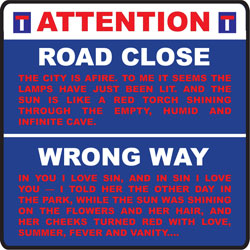Programme
Joao Louro
Portugal
DEAD END
urban intervention
14 June - 13 September 2007
various locations 
The urban intervention Dead End uses the metal surfaces of traffic signs. Usually giving instructions or information to drivers and pedestrians, in this work they are a source of new meanings, such as nonsensical or poetic instructions concerning writers, philosophers, and artists who create new intellectual or emotional directions. Louro is here a sculptor and an architect, he shapes empty spaces and plans the city of language - the signs are a means of communication and they call for active interpretators. They present an attempt at ordering space or avoiding differences and clashes of information. As a starting point for interpretation, we could consider the idea that it is necessary to set off on a journey, no matter where to.
Joao Louro's aim is to define the route of vulnerability of the viewer-interpreter, but without taking the pedestrian from his path.  At best, information is given in order to confuse the interpreter and offer him iconological doubt. At this bottleneck point, the best means of access to the traffic is a lack of knowledge. Deliberately made difficult amongst all the signs is our understanding of which way the traffic is going. For the pedestrian, it would flow in a capillary fashion between these names-spaces and places. For the interpreter, it is a series of communicating vessels, uniting names to thought. Joao Louro's almost industrial recourse to iconology offers no certainties. Where are we going? The question, devoid of any metaphysical connotation, wishes to know where language is taking us. "Only those", says Karl Krauss, "who can create an enigma from a solution are artists."
At best, information is given in order to confuse the interpreter and offer him iconological doubt. At this bottleneck point, the best means of access to the traffic is a lack of knowledge. Deliberately made difficult amongst all the signs is our understanding of which way the traffic is going. For the pedestrian, it would flow in a capillary fashion between these names-spaces and places. For the interpreter, it is a series of communicating vessels, uniting names to thought. Joao Louro's almost industrial recourse to iconology offers no certainties. Where are we going? The question, devoid of any metaphysical connotation, wishes to know where language is taking us. "Only those", says Karl Krauss, "who can create an enigma from a solution are artists."
Joao Louro experiments in his work with ideas that relate to his two primal subjects: language and images. His primary interests are the reorganization of the visual world and of what visuality means, and language in all of its possibilities and aspects. Louro's works can be defined as following on the heels of 1970's conceptual art endeavours or minimalist practices in the theatrical sense. However, he defines himself in opposition to them and his relationship to the finished object is one that goes beyond art historical references. He refuses to be confined to a single medium; taking ideas as a starting point he uses painting, sculpture, photography, drawing, as well as film, selecting media as a conductor selects the musicians for his orchestra. A natural descendant of conceptual and minimal art, Joao Louro has sought to override the romantic paradigm using the importance and role of the viewer, who completes the work of art.
Following an intense blending of references from Warhol to the Situationists and from Kosuth to Wittgenstein, Louro has used and subverted dictionary definitions since the mid 1990's in a series entitled Historia do Crime (The History of Crime). Between 2001 and 2004, using words as a departure point, he created a series of very amusing large-scale neon and steel sign installations under the title Linguagem (Language). Working with traffic sign systems and blending cognoscenti references to art, art history, the history of philosophy, as well as literature and poetry, Louro created a steel panel series under the loose title of Dead End. In the same period he also produced his Blind Images. In them he approaches the realm of images (movies, newspapers, magazines) through painting. To do so, Louro uses captions that refer to an obliterated, missing image that plays with the spectator's capacity to reconstruct the image based on the text.
Selected exhibitions: The Experience of Art in the Italian Pavilion at the 51st International Art Exhibition of the Biennale di Venezia, Blind Runner at Centro Cultural de Belém, Lisbon (2004), Insite 05 - Art Practices in the Public Domain, San Diego/Tijuana (2005) and Play, Rec and Pause, Christopher Grimes, Los Angeles (2006).
-
